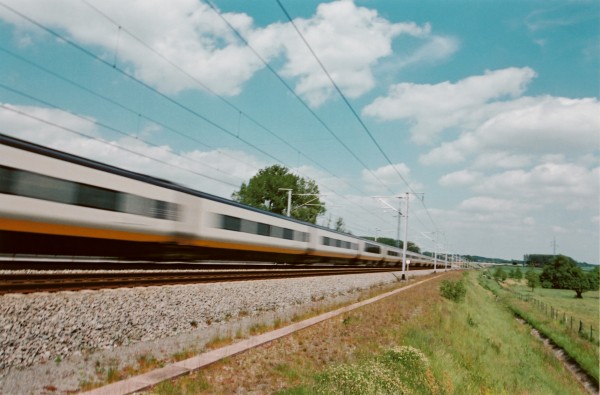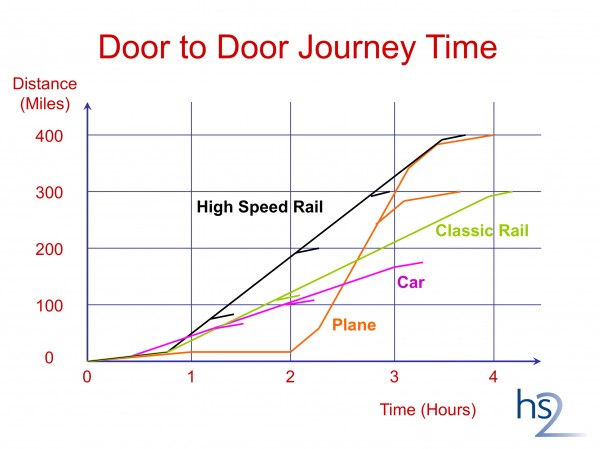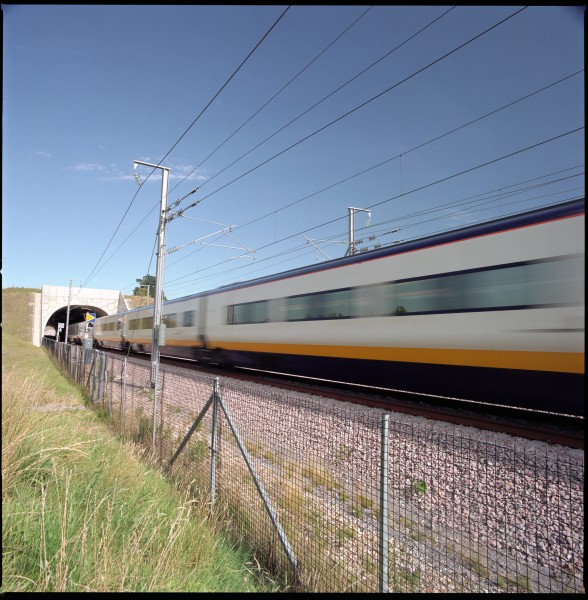The case for high-speed rail – Britain’s 21st century travel solution
Posted: 4 August 2010 | | No comments yet
In Britain, about once a century for the last few hundred years a new long-distance surface transport system has been planned and built to meet the developing needs of a continually advancing society. The 18th century brought the canals and the 19th the railways, both initially more focussed on transporting freight to support the industrial revolution and the development of our cities. Of course, the 20th century brought the trunk motorway network which transformed personal travel. As we get well into the 21st century, we have been considering what is needed to promote the economic and environmental health of this country for the next 100 years.
In Britain, about once a century for the last few hundred years a new long-distance surface transport system has been planned and built to meet the developing needs of a continually advancing society. The 18th century brought the canals and the 19th the railways, both initially more focussed on transporting freight to support the industrial revolution and the development of our cities. Of course, the 20th century brought the trunk motorway network which transformed personal travel. As we get well into the 21st century, we have been considering what is needed to promote the economic and environmental health of this country for the next 100 years.
In Britain, about once a century for the last few hundred years a new long-distance surface transport system has been planned and built to meet the developing needs of a continually advancing society. The 18th century brought the canals and the 19th the railways, both initially more focussed on transporting freight to support the industrial revolution and the development of our cities. Of course, the 20th century brought the trunk motorway network which transformed personal travel. As we get well into the 21st century, we have been considering what is needed to promote the economic and environmental health of this country for the next 100 years.
The essence of high-speed rail (HSR) was first seen in the opening of the Tōkaidō Shinkansan in 1964 – a step change in speed and reliability through creation of a new line dedicated to high traffic flows between major cities and optimised in all its engineering and operational aspects for that purpose. In Britain, the era of steam railways was still drawing to a close. Since then we have become known for our expertise in progressive improvement of our Victorian heritage, and some long-distance trains achieve 150kph end-to-end average speeds. But as traffic grows, upgrading already full railways becomes increasingly difficult and expensive to the point of being hopelessly expensive for diminishing benefit.


The concepts and technologies underpinning HSR can be accepted as providing a known and proven transport system. However, the most vital question before embarking on a national infrastructure project is not an engineering or operational one, or a ‘railway one’, or even solely a transport one; it is, ‘What is it for?’
Two of the fundamental step changes which could be offered by HSR are speed (not surprisingly) and capacity; let’s consider each briefly, in turn.
There is no virtue in speed for its own sake. What is the opportunity that high-speed can bring? In Britain, given our compact geography and distances, internal air travel is relatively limited but car usage is enormous.
For HSR to give equal door-to-door journey times to air between the major centres of London and the central belt of Scotland, consideration of where people live, the proximity of their homes, offices or destinations to airports etc leads to a conclusion that the HSR time needs to be under three hours, which is achievable.
Today, the journey from Birmingham to Manchester (our second and third biggest city regions), a distance of only 120km, takes approximately 1 hour 30 minutes by car or classic rail. As a result, the car enjoys a 96% market share! To compete, the HSR journey time needs to be less than 45 minutes end-to-end. For this we need speeds of at least 320kph. Otherwise the only solution to today’s increasingly congested motorway is…another motorway! This example repeats all over Great Britain.


For high-speed rail to equal door-to-door journey times to air, the journey time between the major centres of London and the central belt of Scotland needs to be under three hours
The early British railways were engineered with considerable foresight, but 200 years on we are acutely aware of the limitations of our inheritance – a mouse-hole sized structure gauge and short platforms. This time we seek to future-proof our proposals – designing for 400kph when we can – with confidence that our children will thank us. But in our crowded country this won’t be easy.
Any new high-speed line will be very expensive and the business case absolutely depends on exploiting its potential capacity to the maximum. Technology advances are either becoming available which will improve train braking performance from high-speed and, together with control system developments, will allow us reduce train separation on open line but of course practical headways depend on junctions and turnouts. The civil, mechanical and electrical engineering worlds of the humble turnout actually dictate capacity, not the open line.
We have to reduce variability in running otherwise reliability will suffer. The human operators, their selection, training and leadership, will remain the make or break of intensive high-speed line operation and thus its capacity and business success. However, by the time a British network is constructed, I am convinced automated train control and operation will be standard on high-speed lines, just as with aircraft and metro rail systems. And with at least Level 3 ERTMS.
Mixing trains with different performance characteristics and cruising speeds can be the biggest capacity destroyer of all. The ability to avoid mixed working has been at the heart of the success of high-speed lines around the world. The possibility of mixing the fastest of conventional classic rail trains with high-speed trains, even on a short length of railway such as between the outskirts of London and the West Midlands, would have a dramatic impact on capacity, undermining the business case for ever building it.
We will build a fully interoperable railway. Where we can run trains on a new route segregated from classic rail, and thus from our Victorian legacy of train size, we can exploit not only the economics of adopting European standard products and technologies, but the capacity opportunities too. Each high-speed train service could have around double the seating capacity of a classic British train.
Specially designed high-speed trains (which tend to be called ‘son of Eurostar’) which have to run on to the classic network to reach their destination, would not have such capability. So an initial service as envisaged for High Speed Two, using today’s technology, would have an hourly capacity of approximately 9,000 passengers an hour. In time, our wider, largely segregated, network with mainly standard high-speed trains, and exploiting the expected technology advances of the next two decades, would give an hourly capacity of double that – 18,000 passengers or more. I always remark, one high-speed line 25m-wide will save two new 100m-wide motorways.
The implications of this enormous capacity have been thought through for the remainder of the system, the stations themselves and passenger handling and dispersal. At full capacity, a terminal station at the end of this trunk in London would be handling the equivalent of a full jumbo jet departing and arriving every 60 seconds. So into the biggest city in Europe we are seeking to add something akin to an airport terminal sized facility. The alternative, suggested increasingly elsewhere, is to spread the load with a second station on the approaches to central London constructed where there is sufficiently good connectivity with public transport systems that passengers have a genuine choice where they access the high-speed service. It would seem the train journey time penalty would be more than offset by the time saved in fully loading and unloading the service at its central terminus.
This leads on to the wider question of ‘city centre’ or out of town ‘parkway’ stations. It will be challenging enough to create central terminus stations. But creating a high-speed corridor into our built up cities will be expensive also – mostly the classic rail corridors are full and the policy of the last 50 years has been of commercial disposal of railway terminal and line of route land deemed surplus to immediate requirements.
The answer to the exam question ‘city centre’ or ‘parkway’ is almost certainly ‘both’. For every city centre-to-city centre journey there are many more which are not. Travel between many cities is often from home in City A to centre of City B or to its suburbs. People can then travel from home to parkway interchange and thence by fast frequent HSR to their destination city. Around these new interchanges, new economic centres will grow, adding prosperity to the city, not replacing that of the centre. Bristol Parkway is the prime British example of this philosophy. Built in fields by a motorway interchange, it is now a thriving new centre, well served by public transport as well as the car.
For smaller cities, the optimum solution will be to get as close to the centre as possible with a through route then concentrate on providing excellent connections in the city itself as has been seen in many places across other railways in Europe. What we see elsewhere, and must seek to replicate in Britain, is a proper joining up of not just transport but land use planning. HSR is sufficiently dramatic in its effect as to make joined-up thinking a necessity if the full benefits of a very expensive new transport system are to be captured.
Which brings us back to Britain – the most crowded country in Europe – and to Southern England, the most populated part of Britain. HS2 Ltd was tasked with finding not just a route but the best route for a new high-speed line between London and the West Midlands. However, a sixth of the route is urban, just to get clear of London. The next sixth is in the Chilterns, an area of outstanding natural beauty and one in which a surprisingly large number of people live in an almost continuous succession of towns, villages and hamlets. There is then some very pleasant countryside before the last sixth in the built-up areas of the West Midlands.
A new high-speed line has to miss centres of population, places of historic significance, of natural beauty and of wildlife and other habitats. So alignment to avoid impacts is very challenging. That high-speed trains have sufficient power to mount relatively steep gradients is our saviour although we do not have the Alps in England! Rather it enables a line to be designed to hug the undulating land which much of the route traverses, minimising high embankments and viaducts which may be seen as intrusive both visually and for noise.
Then there is the possibility of tunnelling. However, tunnels are many times the cost of surface routes, are very large indeed to cope with aerodynamic pressure effects and cause great disruption during construction with the movement of vast quantities of excavated material.
The energy to create a tunnel dominates any calculation of the construction carbon of a new line and this is one of many factors which cause me to turn to the carbon equation of HSR in Britain. The energy for HSR in service is as low carbon as the means of electricity generation. In France, this is a very good story with over 90% of electricity from zero carbon sources, mainly nuclear power. In Britain, where 80% of electricity is from coal, oil and gas, the story is not so good and likely to worsen as elderly nuclear power stations are not replaced.
So what is to be the British network? This is not decided fully yet but a picture is emerging. It will be for elected politicians to decide after extensive public consultation, and quite right too. It is perfectly possible to draw lines on maps sat in London whereby all the major conurbations are connected to the capital. However, a network designed around the needs of the whole country would look very different.
All the major political parties support high-speed rail in principle, but have some different priorities. The initial route announced by the previous government in March 2010 is currently being reviewed by the new government and doubtless there will be changes through the public consultation, planning and political processes which are estimated to take until around 2017. Then construction will begin which will last at least eight years. So book now for you high-speed journey in 2026!


About HS2
HS2 Ltd was created in January 2009 to look at the feasibility of, and business case for, a new high-speed rail line between London and the West Midlands and to consider the case for high-speed rail services linking London, northern England and Scotland.
We delivered a report to Ministers at the end of 2009 which was published in March 2010 alongside the previous Government’s Command Paper on high-speed rail.
The HS2 report and maps showing our recommended route between London and the West Midlands have also been published by the Department for Transport and are available at http://www.dft.gov.uk/pgr/rail/pi/highspeedrail/.
HS2 Ltd has now been asked to plan a full public consultation on the recommended route from London to the West Midlands and to start work on potential route options for high-speed lines from Birmingham to Manchester, and from Birmingham to Leeds, for consultation later. www.hs2.org.uk
About the Author
Andrew McNaughton
Andrew McNaughton is Chief Engineer of High Speed Two Ltd, the company established in February 2009 to develop high-speed rail in Great Britain – its business and wider economic impact as well as engineering and environmental design. He is also Visiting Professor of Engineering at Imperial College, London, and Special Professor of Rail Engineering at Nottingham University. He has recently given a number of keynote lectures on the transport, land use and economic planning effects of highspeed rail on Great Britain in the 21st century.
Andrew has been engaged in railway engineering and management since 1973. His first 20 years in British Rail involved engineering asset management of mixed traffic inter city, urban and freight lines around Britain culminating in leading rebuilding Kent’s railways for the first decade of Channel tunnel operation. With privatisation, he joined Railtrack, taking on operational and general management roles, becoming Head of Production and subsequently Director, Great Western Region. From 2000, he returned to engineering, as Chief Engineer for Railtrack and its successor, Network Rail, where he led the recovery of the GB rail network, re-creating a professional engineering function of all disciplines including ergonomics and research.
Andrew is a Fellow of the Royal Academy of Engineers, the Institution of Civil Engineers and the Institute of Logistics and Transport. In Europe, he is Vice Chairman of the Transport Advisory Group to the EU Commission, Chairman of the European Rail Research Advisory Council and Past Chairman of the International Railway Union’s (UIC) Infrastructure Forum.








